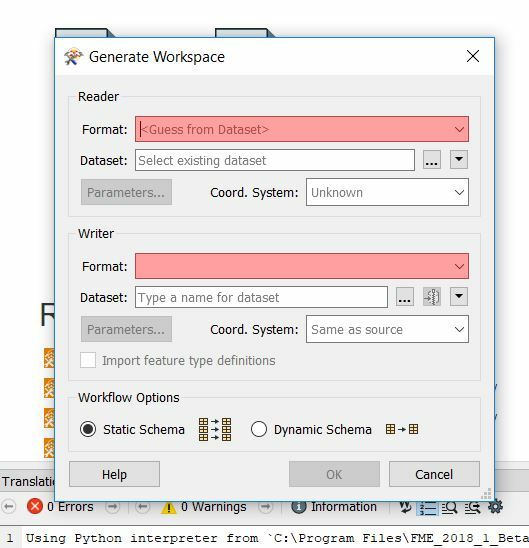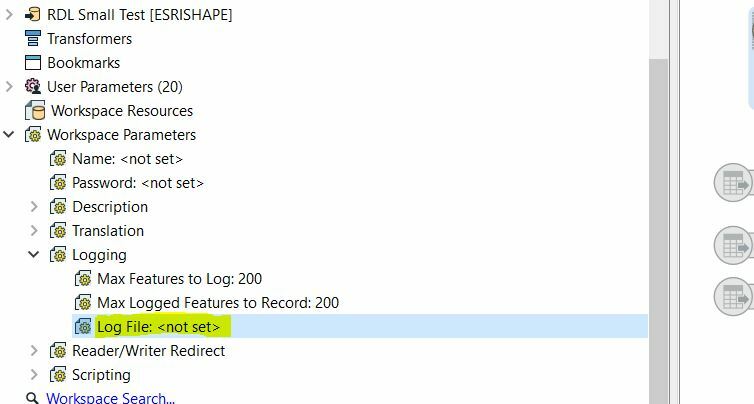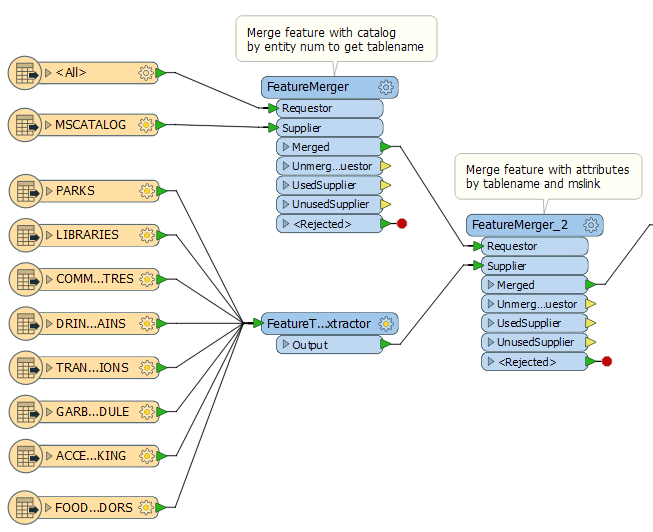Hi @ot_paul,
I believe you can work with Generate Workspace:
File -> New -> Generate Workspace

My question: What kind of attributes from Bentley do you want to Write in Shapefile?
Thanks,
Danilo
Hi @ot_paul,
I believe you can work with Generate Workspace:
File -> New -> Generate Workspace

My question: What kind of attributes from Bentley do you want to Write in Shapefile?
Thanks,
Danilo
Hi @danilo_fme,
I tried using the Bentley MicroStation Design (V8) reader, but unfortunately it is not reading the attributes in the Access file.
I also tried the Bentley MicroStation GeoGraphics reader, but it would not load and output the following error: "The 'feature' table does not exist in the database
The 'mscatalog' table does not exist in the database. Closing the Geographics Reader
Error encountered by the FME. Please refer to the log file or the log window for detail.
Failed to obtain any schemas from reader 'GG' from 1 datasets. This may be due to invalid datasets or format accessibility issues due to licensing, dependencies, or module loading. See logfile for more information."
I want to write attributes from the accompanying Access MDB into the shapefile.
Thanks,
Paul
Hi @danilo_fme,
I tried using the Bentley MicroStation Design (V8) reader, but unfortunately it is not reading the attributes in the Access file.
I also tried the Bentley MicroStation GeoGraphics reader, but it would not load and output the following error: "The 'feature' table does not exist in the database
The 'mscatalog' table does not exist in the database. Closing the Geographics Reader
Error encountered by the FME. Please refer to the log file or the log window for detail.
Failed to obtain any schemas from reader 'GG' from 1 datasets. This may be due to invalid datasets or format accessibility issues due to licensing, dependencies, or module loading. See logfile for more information."
I want to write attributes from the accompanying Access MDB into the shapefile.
Thanks,
Paul
Could you share the template Workspace?
Could you share the template Workspace?
The workspace like below? I have a lot of files, but was only testing with one to start:
rdl-to-shapefile-testing-subset.fmw
The workspace like below? I have a lot of files, but was only testing with one to start:
rdl-to-shapefile-testing-subset.fmw
Thanks for your Workspace.
Could you send just a example Source data?
The workspace like below? I have a lot of files, but was only testing with one to start:
rdl-to-shapefile-testing-subset.fmw
Unfortunately I cannot share any of the data publicly. I can share an image of what one of the folders contains if that helps at all:

OK @ot_paul, not problem.
Please, share the full log file.
OK @ot_paul, not problem.
Please, share the full log file.
Where can I find the full log file? Thanks!
Where can I find the full log file? Thanks!
In Navigator windows and execute again.

Thanks,
Danilo
In Navigator windows and execute again.

Thanks,
Danilo
Here is the log after translating the geometry of several features to shapefiles:
log.zip
Thanks!
Here is the log after translating the geometry of several features to shapefiles:
log.zip
Thanks!
Thanks your Log file.
I did see that its working success DGN to Shapefile.
Thanks your Log file.
I did see that its working success DGN to Shapefile.
Thanks for taking a look. The geometries translate successfully with the Bentley MicroStation Design (V8) reader, but the attributes from the MDB still aren't being read.
Hi @ot_paul
Is necessary to read too in the same workspace the table from MDB, all right?
Hi @ot_paul,
You will need to also read in the MDB file using the Microsoft Access Reader (either MDB_ADO or JDBC).
The features (geometry) from the DGNV8 Reader should have an attribute for the
entity number or ms linkage attribute, which you can use the
FeatureJoiner to join the geometry features and the attributes from the MDB table.
This
documentation may also be useful for you, see mslink_x and entity_num_x
Hi @ot_paul,
On the most basic level, the mslink attribute holds the link to the database table. You can create this attribute on the input by selecting Linkage Extraction - MSLinks in the DGN reader parameters. If you select this option, the attributes mslink_0, mslink1, and mslink_2 will hold the respective mslinks, is present.
If the database is created by Bentley MGE, Geographics, or Map, it will have a catalog table to determine which table the features should link to. This will be named 'mscatalog' or 'catalog' or similar. This linkage will be stored on the feature as entity_num_0, entity_num_1 or entity_num_2.
The FME Geographics reader will automatically link the features to the database tables, but only if the tables are properly named, so it won't work with Bentley Map database.
We can duplicate the process quite simply in the workspace, however:

The top feature is the DGN data, while the others are the tables in the MDB.
The first FeatureMerger merges the DGN data with the catalog table by entity_num_0 to get the tablename for each feature.
The second FeatureMerger merges the DGN data to its respective table row by tablename and mslink_0.
I have attached the workspace: readbentley.fmw
Hi @ot_paul,
You will need to also read in the MDB file using the Microsoft Access Reader (either MDB_ADO or JDBC).
The features (geometry) from the DGNV8 Reader should have an attribute for the
entity number or ms linkage attribute, which you can use the
FeatureJoiner to join the geometry features and the attributes from the MDB table.
This
documentation may also be useful for you, see mslink_x and entity_num_x
Hi Andrea,
Thanks for the info. I had to swap to 32-bit FME to load the Access Reader. I see the mslink and entity_num in the Access database, but I'm not sure where to find them in the DGNV8 Reader. I wrote all the DGN attributes to a shapefile, inspected it, and couldn't seem to find any column I could join to the mslink or entity_num fields.
Hi @ot_paul,
On the most basic level, the mslink attribute holds the link to the database table. You can create this attribute on the input by selecting Linkage Extraction - MSLinks in the DGN reader parameters. If you select this option, the attributes mslink_0, mslink1, and mslink_2 will hold the respective mslinks, is present.
If the database is created by Bentley MGE, Geographics, or Map, it will have a catalog table to determine which table the features should link to. This will be named 'mscatalog' or 'catalog' or similar. This linkage will be stored on the feature as entity_num_0, entity_num_1 or entity_num_2.
The FME Geographics reader will automatically link the features to the database tables, but only if the tables are properly named, so it won't work with Bentley Map database.
We can duplicate the process quite simply in the workspace, however:

The top feature is the DGN data, while the others are the tables in the MDB.
The first FeatureMerger merges the DGN data with the catalog table by entity_num_0 to get the tablename for each feature.
The second FeatureMerger merges the DGN data to its respective table row by tablename and mslink_0.
I have attached the workspace: readbentley.fmw
Hi @DaveAtSafe,
Thanks for the examples. I am trying to set a similar workspace up, but I do not seem to have a tablename column like was provided. Part of my table with the Entity information is shown below and I have attached my current workspace.

rdl-to-shapefile-testing-subset.fmw
Hi @DaveAtSafe,
Thanks for the examples. I am trying to set a similar workspace up, but I do not seem to have a tablename column like was provided. Part of my table with the Entity information is shown below and I have attached my current workspace.

rdl-to-shapefile-testing-subset.fmw
Hi @ot_paul,
Would you mind sharing your data with me? If you don't want to make it public, please send a download link (ie. Google Drive, Dropbox) to support@safe.com, with Attn. Dave in the subject line. I can be of more help if I can see the table structures.





